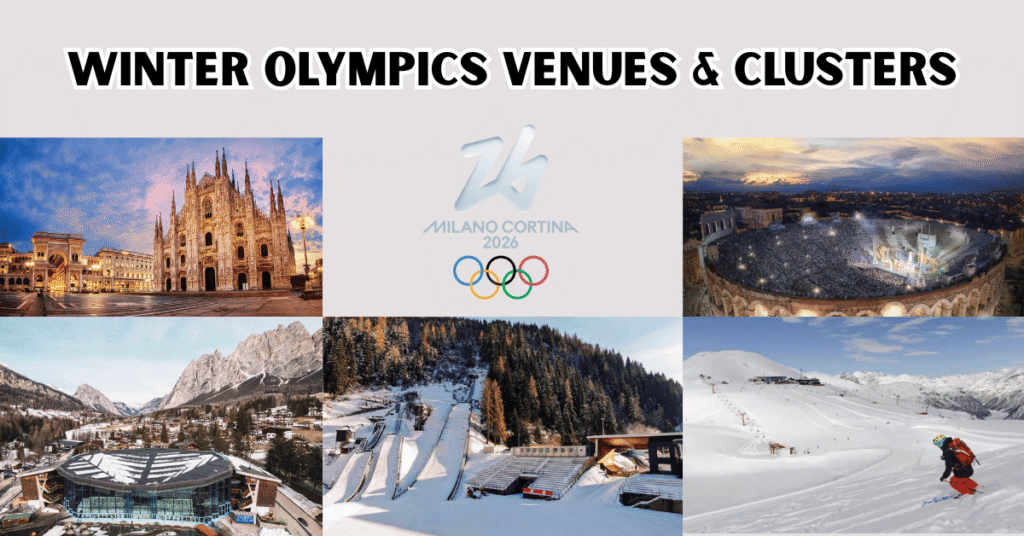The 2026 Winter Olympics will be held in Italy from February 6 to 22, 2026. The official name is Milano Cortina 2026, showing the shared hosting between Milan and Cortina d’Ampezzo. This edition will not stay in one city. Events will be spread across five clusters: Milan, Cortina, Verona, Valtellina, and Val di Fiemme.
Fans will see competitions in modern arenas, mountain resorts, and historic landmarks. The Opening Ceremony takes place at San Siro Stadium in Milan. The Closing Ceremony will be staged at the ancient Verona Arena.
Where are the 2026 Winter Olympics?
The Games will be staged in Northern Italy. The main hosts are Milan and Cortina d’Ampezzo, with events shared across Verona, Valtellina, and Val di Fiemme.
This is the first Winter Olympics to follow a multi-cluster model. Instead of one main city, several regions will share the spotlight. This setup lets Italy use existing world-class venues and highlight both city life and the Alps.
2026 Winter Olympics Host Cities and Clusters Explained
The 2026 Winter Olympics will be the most widespread Winter Games in history. Competitions will take place across five clusters. Most venues already exist, while a few new builds are underway. This model reduces costs, limits construction, and showcases both historic and modern sites.

Milan Host City
- San Siro Stadium: Opening Ceremony (75,817 seats, existing).
- PalaItalia Santa Giulia: Ice hockey prelims and finals (16,000 seats, new).
- Milan Ice Park at Fiera Milano: Ice hockey prelims (12,000 seats) and speed skating (6,500 seats, temporary stands).
- Forum di Milano (Mediolanum Forum, Assago): Figure skating and short track (12,700 seats, existing).
Cortina d’Ampezzo Host City
- Olimpia delle Tofane: Women’s alpine skiing (1,000 main grandstand, existing).
- South Tyrol Arena (Anterselva/Antholz): Biathlon (9,000 seats, existing).
- Stadio Olimpico del Ghiaccio: Curling (7,000 seats, existing).
- Cortina Sliding Centre: Bobsleigh, luge, skeleton (capacity TBD, rebuilt).
Valtellina Cluster (Bormio and Livigno)
- Stelvio slope in Bormio: Men’s alpine skiing and ski mountaineering (capacity TBD, existing).
- Livigno (Mottolino, Sitas-Tagliede, Carosello 3000): Snowboarding and freestyle skiing (capacities TBD, existing).
Val di Fiemme Cluster
- Giuseppe Dal Ben Ski Jumping Arena, Predazzo: Ski jumping and Nordic combined (capacity TBD, existing).
- Tesero Cross-Country Skiing Stadium: Cross-country skiing and Nordic combined (50,000 seats, existing).
Verona Host City
- Verona Arena: Closing Ceremony (20,000 seats, existing Roman amphitheater).
2026 Olympics Venues: Quick Overview
| Cluster / Host City | Main Venues | Sports & Events | Capacity | Status |
|---|---|---|---|---|
| Milan | San Siro, PalaItalia, Milan Ice Park, Forum di Milano | Opening Ceremony, ice hockey, figure skating, speed skating | 6,500–75,817 | Mostly existing, one new |
| Cortina d’Ampezzo | Tofane, South Tyrol Arena, Stadio Olimpico, Sliding Centre | Alpine skiing (women), curling, biathlon, bobsleigh, luge, skeleton | 1,000–9,000+ | Existing, upgraded |
| Valtellina | Stelvio, Livigno slopes & parks | Men’s alpine, ski mountaineering, snowboard, freestyle | TBD | Existing |
| Val di Fiemme | Tesero, Predazzo | Cross-country, Nordic combined, ski jumping | Up to 50,000 | Existing |
| Verona | Verona Arena | Closing Ceremony | 20,000 | Existing |
This cluster model makes Milano Cortina 2026 different from every past Winter Olympics. Fans will move between big cities and alpine towns, seeing both tradition and modern sport.
Why Italy Was Chosen as Host
Italy won the right to host because of its long history in winter sports and strong venues. Cortina d’Ampezzo held the Winter Olympics in 1956 and still stands as a classic ski destination. Milan offers modern transport, hotels, and arenas to support a global event.
The focus on sustainability also helped Italy win. Most venues already exist or were updated instead of building from zero. This plan saves money and reduces the impact on the environment while still delivering Olympic-level facilities.
Key Highlights for Fans
The 2026 Winter Olympics will give fans a mix of culture and sport.
- San Siro Stadium in Milan will host the Opening Ceremony
- The Verona Arena, nearly 2,000 years old, will stage the Closing Ceremony
- Cortina and Bormio bring world-class alpine skiing
- Livigno is set for freestyle and snowboarding events
- Val di Fiemme is a traditional hub for cross-country and ski jumping
Fans can expect a unique Olympic experience that moves between city life and alpine competition.
2026 Winter Olympics Location FAQs
Where will the 2026 Winter Olympics be held?
In Northern Italy across Milan, Cortina d’Ampezzo, Verona, Valtellina and Val di Fiemme.
Which cities are hosting Milano Cortina 2026?
The main hosts are Milan and Cortina d’Ampezzo. Events also take place in Verona, Bormio, Livigno and Val di Fiemme.
How many clusters are there in the 2026 Winter Olympics?
There are five clusters: Milan, Cortina, Verona, Valtellina, and Val di Fiemme.
What dates are the 2026 Winter Olympics?
From February 6 to 22, 2026, with some events starting February 4.
Where are the skiing events in 2026?
Men’s alpine skiing is in Bormio, women’s alpine in Cortina, freestyle and snowboarding in Livigno, and Nordic skiing in Val di Fiemme.
Where are the Ice Hockey events in 2026?
Ice hockey will be played in Milan. The main venue is the new PalaItalia arena, with additional games at the Mediolanum Forum.
The 2026 Winter Olympics will be hosted across Milan, Cortina d’Ampezzo, Verona, Valtellina, and Val di Fiemme. It will be the most widespread Winter Games ever staged. Fans will see sport in modern arenas, historic resorts and cultural landmarks, all set in the heart of Northern Italy.



